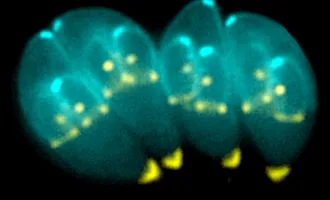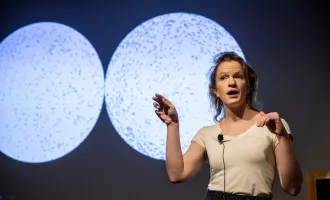Journal Club: Cell Biology, Cancer Biology, Immunology, and Microbiology
CELL BIOLOGY: Mitochondrial network size scaling in budding yeast. Rafelski, S.M. et al. (Marshall). Science. 338(6108):822-4.
A small cell needs less energy production than a large cell of the same type, which means that there are fewer and smaller mitochondria in small cells as compared to large cells. When cells divide, they divide their mitochondria evenly among the two daughter cells; the mitochondria then grow with the growing cells. How do cells that divide asymmetrically regulate their mitochondria? In this paper, researchers used advanced microscopy to follow budding yeast through multiple generations and measured both cell volume and mitochondrial size.
They found that while buds (the smaller daughter cell) rapidly gain mitochondria as they increase in volume, the mothers (the larger daughter cell) tend to lose mitochondria in proportion to their size, suggesting that buds accumulate mitochondria at the expense of the mother cell. Despite this, both bud and mother attain similar ratios of mitochondrial size to cell volume by the time of division.
CANCER BIOLOGY: SOX4 enables oncogenic survival signals in acute lymphoblastic leukemia. Ramezani-Rad, P. et al. (Müschen). Blood. November 14. [Epub ahead of print]
B-cells undergo multiple checkpoints during development to ensure adequate functionality and a lack of self-reactivity. An example of a gene that assists during very early B-cell development is SOX4, which regulates the transcription of many genes controlling development at specific checkpoints. In some forms of acute lymphoblastic leukemia (ALL), genetic mutations cause pre-B-cells (which have not completed their differentiation) to proliferate uncontrollably. Here, researchers found that ALL B-cells respond to SOX4 despite having already passed early developmental checkpoints, which causes them to aberrantly divide. They found that normal pre-B-cells do not respond to a loss in SOX4, while ALL cells lose their ability to proliferate without SOX4.
IMMUNOLOGY: Splenic red pulp macrophages produce type I interferons as early sentinels of malaria infection but are dispensable for control. Kim, C.C. et al. (Derisi). PLoS One. 7(10):e48126.
Type I interferons are proteins secreted by immune cells upon activation by pathogens or pathogen-derived molecules and initiate antiviral and anti-tumor responses. Therefore, they are considered the first line of defense against viral infection. Interestingly, it has been reported that type I interferons are produced in response to malarial infection — and malaria is not a virus, but a parasite. Here, researchers sought to clarify which cells might be producing interferon in response to malaria infection and how the interferon might fight infection. By looking at the spleens of malaria-infected mice, the researchers found that both plasmacytoid dendritic cells and splenic red pulp macrophages produced large quantities of interferon. Furthermore, they used a mouse deficient in splenic red pulp macrophages to show that they are dispensable for controlling malarial infection, as other researchers have similarly found with plasmacytoid dendritic cells.
MICROBIOLOGY: Therapeutic helminth infection of macaques with idiopathic chronic diarrhea alters the inflammatory signature and mucosal microbiota of the colon. Broadhurst, M.J. et al. (Loke). PLoS Pathogens. 8(11):e1003000.
The hygiene hypothesis states that allergies arise from an environment that is too clean: without pathogens to keep our immune system occupied, it will respond instead to harmless environmental antigens and cause conditions like asthma, eczema and colitis. You might guess that according to this hypothesis, animals housed in ultra-clean environments (such as those found in animal facilities) may also develop symptoms of allergic disease. In fact, in one example, macaques housed in captivity often suffer from idiopathic chronic diarrhea (ICD), which strongly resembles ulcerative colitis. Here, researchers describe a new treatment for ICD in which the macaque is intentionally infected with a parasite. Infection with the parasite dramatically decreased symptoms of ICD, as a result of a change in the T-cells of the gut, decreased bacterial adherence to the gut mucosa and a change in the types of bacteria present in the gut.


